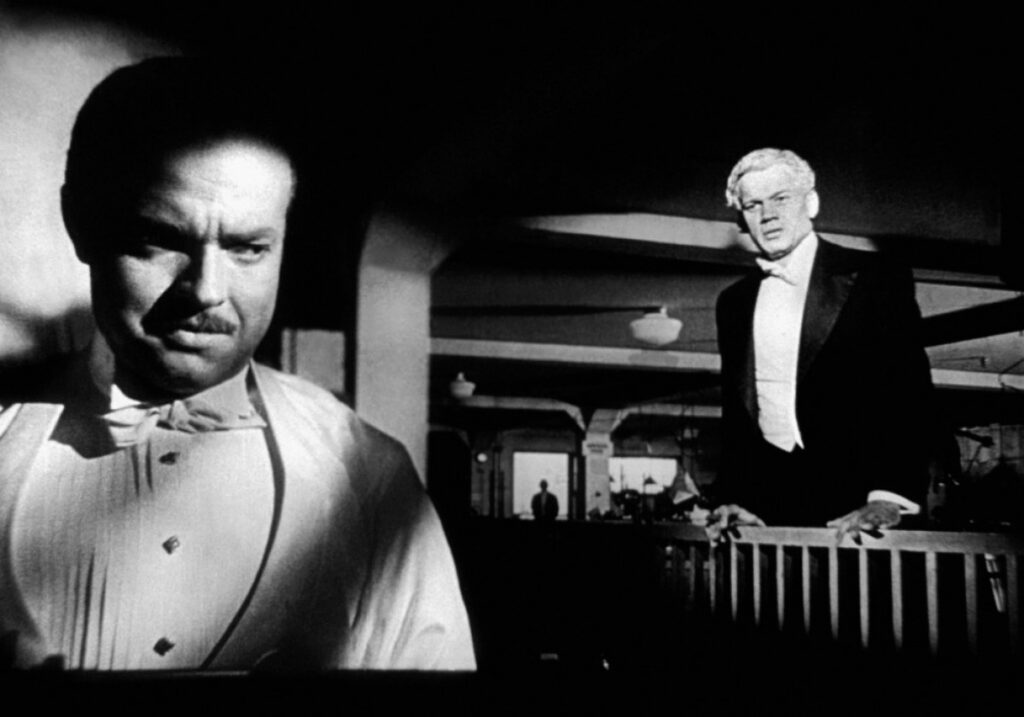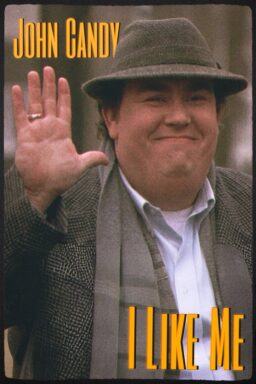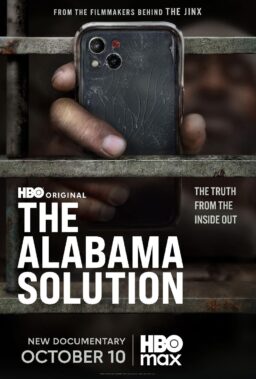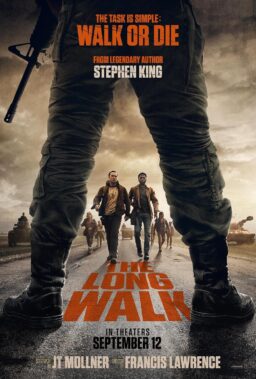“Rosebud.” The most famous word in the history of cinema. It explains everything, and nothing. Who, for that matter, actually heard Charles Foster Kane say it before he died? The butler says, late in the film, that he did. But Kane seems to be alone when he dies, and the reflection on the shard of glass from the broken paperweight shows the nurse entering the room. Gossip has it that the screenwriter, Herman Mankiewicz, used “rosebud” as an inside joke, because as a friend of Hearst’s mistress, Marion Davies, he knew “rosebud” was the old man’s pet name for the most intimate part of her anatomy.
Deep Focus. Everyone knows that Orson Welles and his cinematographer, Gregg Toland, used deep focus in Kane. But what is deep focus, and were they using it for the first time? The term refers to a strategy of lighting, composition, and lens choice that allows everything in the frame, from the front to the back, to be in focus at the same time. With the lighting and lenses available in 1941, this was just becoming possible, and Toland had experimented with the technique in John Ford’s The Long Voyage Home a few years earlier. In most movies, the key elements in the frame are in focus, and those closer or further away may not be. When everything is in focus, the filmmakers must give a lot more thought to how they direct the viewer’s attention, first here and then there. What the French call mise-en-scene–the movement within the frame– becomes more important.
Optical illusions. Deep focus is especially tricky because movies are two-dimensional, and so you need visual guideposts to determine the true scale of a scene. Toland used this fact as a way to fool the audience’s eye on two delightful occasions in the film. One comes when Kane is signing away control of his empire in Thatcher’s office. Behind him on the wall are windows that look of normal size and height. Then Kane starts to walk into the background of the shot, and we realize with surprise that the windows are huge, and their lower sills are more than six feet above the floor. As Kane stands under them, he is dwarfed–which is the intent, since he has just lost great power. Later in the film, Kane walks over to stand in front of the great fireplace in Xanadu, and we realize it, too, is much larger than it first seemed.
Visible ceilings. In almost all movies before Citizen Kane, you couldn’t see the ceilings in rooms because there weren’t any. That’s where you’d see the lights and microphones. Welles wanted to use a lot of low-angle shots that would look up toward ceilings, and so Toland devised a strategy of cloth ceilings that looked real but were not. The microphones were hidden immediately above the ceilings, which in many shots are noticeably low.
Matte drawings. These are drawings by artists that are used to create elements that aren’t really there. Often they are combined with “real” foregrounds. The opening and closing shots of Kane’s great castle, Xanadu, are examples. No exterior set was ever built for the structure. Instead, artists drew it, and used lights behind it to suggest Kane’s bedroom window. “Real” foreground details such as Kane’s lagoon and private zoo were added.
Invisible wipes. A “wipe” is a visual effect that wipes one image off the screen while wiping another into view. Invisible wipes disguise themselves as something else on the screen that seems to be moving, so you aren’t aware of the effect. They are useful in “wiping” from full-scale sets to miniature sets. For example: One of the most famous shots in Kane shows Susan Alexander’s opera debut, when, as she starts to sing, the camera moves straight up to a catwalk high above the stage, and one stagehand turns to another and eloquently reviews her performance by holding his nose. Only the stage and the stagehands on the catwalk are real. The middle portion of this seemingly unbroken shot is a miniature, built in the RKO model workshop. The model is invisibly wiped in by the stage curtains, as we move up past them, and wiped out by a wooden beam right below the catwalk. Another example: In Walter Thatcher’s library, the statue of Thatcher is a drawing, and as the camera pans down it wipes out the drawing as it wipes in the set of the library.
Invisible Furniture Moving. In the early scene in the Kanes’s cabin in Colorado, the camera tracks back from a window to a table where Kane’s mother is being asked to sign a paper. The camera tracks right through where the table would be, after which it is slipped into place before we can see it. But a hat on the table is still trembling from the move. After she signs the paper, the camera pulls up and follows her as she walks back toward the window. If you look sharply, you can see that she’s walking right through where the table was a moment before.
The Neatest Flash-Forward in Kane. Between Thatcher’s words “Merry Christmas” and “… a very Happy New Year,” two decades pass.
From Model to Reality. As the camera swoops above the night club and through the skylight to discover Susan Alexander Kane sitting forlornly at a table, it goes from a model of the nightclub roof to a real set. The switch is concealed, the first time, by a lightning flash. The second time we go to the nightclub, it’s done with a dissolve.
Crowd scenes. There aren’t any in Citizen Kane. It only looks like there are. In the opening newsreel, stock footage of a political rally is intercut with a low-angle shot showing one man speaking on behalf of Kane. Sound effects make it sound like he’s at a big outdoor rally. Later, Kane himself addresses a gigantic indoor rally. Kane and the other actors on the stage are real. The audience is a miniature, with flickering lights to suggest movement.
Slight Factual Discrepancies. In the opening newsreel, Xanadu is described as being “on the desert coast of Florida.” But Florida does not have a desert coast, as you can plainly see during the picnic scene, where footage from an earlier RKO prehistoric adventure was back-projected behind the actors, and if you look closely, that seems to be a pterodactyl flapping its wings.
The Luce Connection. Although Citizen Kane was widely seen as an attack on William Randolph Hearst, it was also aimed at Henry R. Luce and his concept of faceless group journalism, as then practiced at his Time magazine and March of Time newsreels. The opening “News on the March” segment is a deliberate parody of the Luce newsreel, and the reason you can never see the faces of any of the journalists is that Welles and Mankiewicz were kidding the anonymity of Luce’s writers and editors.
An Extra with a Future. Alan Ladd can be glimpsed in the opening newsreel sequence, and again in the closing warehouse scene.
Most Thankless Job on the Movie. It went to William Alland, who plays Mr. Thompson, the journalist assigned to track down the meaning of “Rosebud.” He is always seen from behind, or in backlit profile. You can never see his face. At the movie’s world premiere, Alland told the audience he would turn his back so they could recognize him more easily.
The Brothel Scene. It couldn’t be filmed. In the original screenplay, after Kane hires away the staff of the Chronicle, he takes them to a brothel. The Production Code office wouldn’t allow that. So the scene, slightly changed, takes place in the Inquirer newsroom, still with the dancing girls.
The Eyeless Cockatoo. Yes, you can see right through the eyeball of the shrieking cocatoo, in the scene before the big fight between Kane and Susan. It’s a mistake.
The Most Evocative Shot in the Movie. There are many candidates. My choice is the shot showing an infinity of Kanes reflected in mirrors as he walks past.
The Best Speech in Kane. My favorite is delivered by Mr. Bernstein (Everett Sloane), when he is talking about the magic of memory with the inquiring reporter: “A fellow will remember a lot of things you wouldn’t think he’d remember. You take me. One day, back in 1896, I was crossing over to Jersey on the ferry, and as we pulled out, there was another ferry pulling in, and on it there was a girl waiting to get off. A white dress she had on. She was carrying a white parasol. I only saw her for one second. She didn’t see me at all, but I’ll bet a month hasn’t gone by since, that I haven’t thought of that girl.”
Genuine Modesty. In the movie’s credits, Welles allowed his director’s credit and Toland’s cinematography credit to appear on the same card–an unprecedented gesture that indicated how grateful Welles was.
False Modesty. In the unique end credits, the members of the Mercury Company are introduced and seen in brief moments from the movie. Then smaller parts are handled with a single card containing many names. The final credit down at the bottom, in small type, says simply: Kane……………Orson Welles












